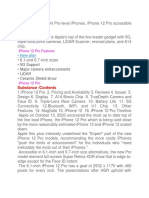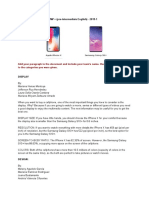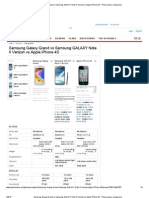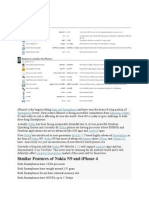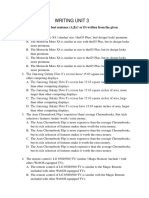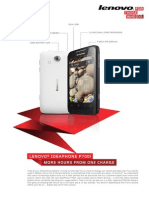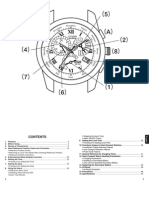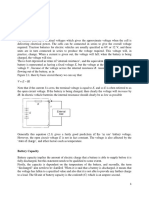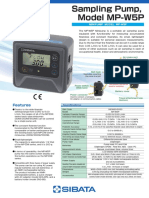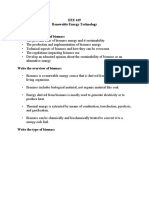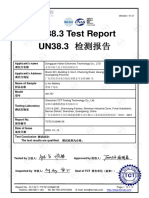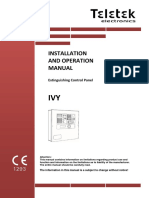Samsung Galaxy S II
Samsung Galaxy S II
Uploaded by
jl520Copyright:
Available Formats
Samsung Galaxy S II
Samsung Galaxy S II
Uploaded by
jl520Copyright
Available Formats
Share this document
Did you find this document useful?
Is this content inappropriate?
Copyright:
Available Formats
Samsung Galaxy S II
Samsung Galaxy S II
Uploaded by
jl520Copyright:
Available Formats
Samsung Galaxy S II
AT&T, T-Mobile, Sprint (called Epic 4G Touch)
The Galaxy S II is an absolutely awesome phone. It's been flying off the shelves in Asia and Europe, and only just recently made it to the United States on AT&T, T-Mobile (available starting Oct. 12), and Sprint (called the Epic 4G Touch). The Samsung Galaxy S II is the phone to get if you want the very best. Why? Here's what it's made of: *There are slight differences depending on which service provider you get the phone on.* Huge 4.52" AMOLED (4.3" on AT&T) screen. The iPhone 4S only has a 3.5" screen. Win! The Galaxy S II screen is big, bright, and beautiful. 1.2 GHz dual-core Exynos processor (1.5 GHz Snapdragon on T-Mobile). Easily faster than the iPhone. There's no good reason for Apple to be playing catch-up all the time. They simply went from a single-core processor to a dual-core processor, which most top Android phones have had for over a year now. The Galaxy S II comes with a microSD storage card, which the iPhone 4S does not have. The iPhone may have more storage out of the box, but if you get the 16 GB version and find you need more space, you're out of luck. You're stuck with 16 GB. The Galaxy S II comes with an extra 8 GB card (in addition to the 16 GB or 32 GB built-in) which can be changed for a 32 GB card. Also, you can have as many microSD cards as you want, so there's essentially unlimited storage capacity. The Galaxy S II weighs 116 grams compared to the 140 grams the iPhone 4S weighs. 140 grams isn't exactly a heavyweight, but at 116 grams, the Galaxy S II is almost a featherweight. I've had phones in about the same weights, and I can tell you that you'll feel the difference in your pocket over time.
Motorola Droid Bionic
Verizon
Sadly, the Samsung Galaxy S II will not be available on Verizon. If you're one of these unfortunate souls, the phone to get is the Motorola Droid Bionic. There are several reasons why it's better than the iPhone 4S, so I'll share them with you. 4G LTE is fast. Super fast; and it's not available on the iPhone 4S. This was a huge oversight by Apple, because if they'd had LTE, it would have killed any serious competition. What's LTE? LTE Stands for Long Term Evolution and it's the next giant Internet speed bump on cell phones. Only large cities have LTE at the moment, but all the major carriers are hard at work upgrading their equipment and it will be much more widespread soon enough. By including LTE on the Droid Bionic, Motorola has made this phone future proof while the iPhone 4S will look like a snail in a year or two. Large 4.3" screen. Again, another phone with a big, beautiful screen that the iPhone 4S can't match. Even with Retina Display, the iPhone 4S screen is simply too small for a lot of people. Flash on the 8 MP HD camera. Like the Galaxy S II, the Droid Bionic has a flash on the back camera. Unlike the iPhone 4S. Simply unacceptable of Apple to not be including a flash on the iPhone 4S camera.
Dock. The Droid Bionic has an optional dock that lets you use a keyboard and mouse with it, just like you're using a regular computer. This is more functionality than the iPhone 4S could give you because the iPhone 4S doesn't have much in the way of editing documents or spreadsheets. With this, the Droid Bionic almost becomes a replacement for a netbook or laptop. Sweet! Although it's a bit larger than an iPhone 4S, it manages to pack a lot more into it's package. It's the slimmest and lightest phone with 4G LTE and a dual-core processor. If I had to get a phone on Verizon, this is the one I'd get.
iPhone 4
HTC EVO 4G
Nokia N8
Palm Pre Plus
HTC HD2
Platform Processor
iOS 4 Apple A4
Android 2.1 with Sense 1GHz Qualcomm Snapdragon 440MB internal, microSDHC expansion
Symbian^3 680MHz ARM11-based 16GB internal, microSDHC expansion
webOS 600MHz TI OMAP3430 16GB
Windows Mobile 6.5 1GHz Qualcomm Snapdragon Approx. 200MB internal, microSDHC expansion
Storage
16GB / 32GB internal
Cellular
Quadband GSM, CDMA, EV-DO Quadband GSM, CDMA / EV-DO Quadband GSM, pentaband HSPA Rev. A, WiMAX pentaband HSPA Rev. A or dualband HSPA quadband GSM / dualband HSPA 802.11b/g/n 3.5 inches 960 x 640 IPS LCD No 5 megapixel AF, LED flash VGA 720p at 30fps Yes (WiFi only) 802.11b/g 4.3 inches 800 x 480 LCD HDMI 802.11b/g/n 3.5 inches 640 x 360 AMOLED HDMI 802.11b/g 3.1 inches 480 x 320 LCD No 3 megapixel, LED flash None VGA at 30fps No AGPS, accelerometer SIM (on GSM 802.11b/g1 4.3 inches 800 x 480 LCD No 5 megapixel AF, LED flash None VGA at 30fps No AGPS, compass, accelerometer SIM
WiFi Display size Display resolution Display technology Integrated TVout Primary camera Secondary camera Video recording Video calling Location / orientation sensors SIM standard
8 megapixel AF, 12 megapixel LED flash AF, xenon flash 1.3 megapixel 720p at 24fps Yes VGA 720p at 25fps Yes
AGPS, compass, AGPS, compass, AGPS, compass, accelerometer, accelerometer accelerometer gyroscope Micro SIM N/A SIM
variant) Quoted max talk time Quoted max media playback time Weight Dimensions 7 hours on 3G, 14 hours on 2G 40 hours audio, 10 hours video 137 grams / 4.8 oz. 115.2 x 58.6 x 9.3mm 6 hours 5.83 hours on 5.5 hours on 3G, 12 hours on Verizon, 5 hours 2G on AT&T 50 hours audio, 6 hours video None quoted 5.33 hours on 3G, 6.33 hours on 2G 12 hours audio, 8 hours video
None quoted
170 grams / 6.00 135 grams / 4.76 135 grams / 4.76 157 grams / 5.54 oz. oz. oz. oz. 122 x 66 x 13mm 113.5 x 59 x 12.9mm 100.5 x 59.5 x 16.95mm 120.5 x 67 x 11mm
Rechargeable lithium-based technology currently provides the best performance for your Apple notebook computer, iPod, iPhone, or iPad. You can also find this standard battery technology in many other devices. Apple batteries share the characteristics common to lithium-based technology in other devices. Like other rechargeable batteries, these batteries may eventually require replacement.
Standard Technology
Lithium-ion polymer batteries pack in a higher power density than nickel-based batteries. This gives you a longer battery life in a lighter package, as lithium is the lightest metal. You can also recharge a lithium-ion polymer battery whenever convenient, without the full charge or discharge cycle necessary to keep nickel-based batteries at peak performance. (Over time, crystals build up in nickel-based batteries and prevent you from charging them completely, necessitating an inconvenient full discharge.)
Standard Charging
Most lithium-ion polymer batteries use a fast charge to charge your device to 80% battery capacity, then switch to trickle charging. Thats about two hours of charge time to power an iPod to 80% capacity, then another two hours to fully charge it, if you are not using the iPod while charging. You can charge all lithium-ion batteries a large but finite number of times, as defined by charge cycle.
Charge Cycle. Using and recharging 100% of battery capacity equals one full charge cycle. A charge cycle means using all of the batterys power, but that doesnt necessarily mean a single charge. For instance, you could listen to your iPod for a few hours one day, using half its power, and then recharge it fully. If you did the same thing the next day, it would count as one charge cycle, not two, so you may take several days to complete a cycle. Each time you complete a charge cycle, it diminishes battery capacity slightly, but you can put notebook, iPod, and iPhone batteries through many charge cycles before they will only hold 80% of original battery capacity. As with other rechargeable batteries, you may eventually need to replace your battery.
iPhone Temperate Zone. Your iPhone works best from 32 to 95 F. You should store it in environments of -4 to 113 F. Thats 0 to 35 C and -20 to 45 C for the metrically inclined. Keeping your iPhone as near room temperature as possible (72 F or 22 C) is ideal.
You might also like
- Hello: Stock Weigh 300Document23 pagesHello: Stock Weigh 300Андрей ИвановNo ratings yet
- KKK A 1822F 08.01Document69 pagesKKK A 1822F 08.01jmcd01No ratings yet
- Physics Performance TaskDocument9 pagesPhysics Performance TaskAlyssa MauricioNo ratings yet
- 5G Deployment Continues To Expand Across The USDocument21 pages5G Deployment Continues To Expand Across The USyowNo ratings yet
- Iphone 4 TeardownDocument54 pagesIphone 4 TeardownShahid Aziz100% (1)
- Smart Phones Under 35000Document13 pagesSmart Phones Under 35000Anurag BuchkeNo ratings yet
- Iphone Xs Max (US-Canada-A1921) 64, 256, 512 GB Specs (A1921, MT5A2LL-A, 3219, IPhone11,6)Document6 pagesIphone Xs Max (US-Canada-A1921) 64, 256, 512 GB Specs (A1921, MT5A2LL-A, 3219, IPhone11,6)Agung WelterNo ratings yet
- Apple Against The World: Iphone 5 Vs Samsung Galaxy S Iii Vs Nokia Lumia 920Document3 pagesApple Against The World: Iphone 5 Vs Samsung Galaxy S Iii Vs Nokia Lumia 920Xymon BassigNo ratings yet
- Iphone OfferDocument10 pagesIphone Offermezbah uddinNo ratings yet
- Iphone OfferDocument10 pagesIphone OfferMezba Uddin SayeemNo ratings yet
- Iphone 12 Pro ReviewDocument10 pagesIphone 12 Pro Reviewmezbah uddinNo ratings yet
- Iphone OfferDocument10 pagesIphone OfferMezba Uddin SayeemNo ratings yet
- New Plan: Iphone 12 Pro FeaturesDocument10 pagesNew Plan: Iphone 12 Pro FeaturesMojahid ParvezNo ratings yet
- Iphone OfferDocument10 pagesIphone Offermezbah uddinNo ratings yet
- Description and Specifications: Iphone 3GsDocument8 pagesDescription and Specifications: Iphone 3GsJr GoNo ratings yet
- The Easy iPhone 13 Pro Max User Guide: The Complete Reference Guide to Getting Started with iPhone 13 Pro Max Series with the Best iOS 15 Tips & Tricks to Help You Learn MoreFrom EverandThe Easy iPhone 13 Pro Max User Guide: The Complete Reference Guide to Getting Started with iPhone 13 Pro Max Series with the Best iOS 15 Tips & Tricks to Help You Learn MoreNo ratings yet
- I PadDocument3 pagesI PadwalidalzubayerNo ratings yet
- The Best CellphonesDocument12 pagesThe Best CellphonesLibier CejaNo ratings yet
- Review of Mobile PhonesDocument13 pagesReview of Mobile PhonesJOSHUA LING YONG ONN MoeNo ratings yet
- Comparing - Safiqul Faiz Al Fatah - C1A022038Document4 pagesComparing - Safiqul Faiz Al Fatah - C1A022038Ikki RamaNo ratings yet
- Refurbished Iphone 12 Pro Max 512GB - Graphite (Unlocked) - AppleDocument2 pagesRefurbished Iphone 12 Pro Max 512GB - Graphite (Unlocked) - AppleAgung WelterNo ratings yet
- Iphone 11 Pro MaxDocument35 pagesIphone 11 Pro MaxAPURBA PALNo ratings yet
- I PhoneDocument8 pagesI PhoneMeyliza Veronica SiregarNo ratings yet
- Comparison of PhonesDocument1 pageComparison of PhonesperfectlymanifestedNo ratings yet
- Iphone 7 TeardownDocument68 pagesIphone 7 TeardownShahid AzizNo ratings yet
- Nexus 6PDocument5 pagesNexus 6Prohitboy123No ratings yet
- Texto Del Projecto FinalDocument5 pagesTexto Del Projecto Finalapi-455950394No ratings yet
- iPhone 12 Pro Max User Guide: An Amazing, Simple, And Complete Pictures-illustrated Manual to Master the New iPhone 12 Pro Max and iOS 14 for Beginners, Seniors, And ProsFrom EverandiPhone 12 Pro Max User Guide: An Amazing, Simple, And Complete Pictures-illustrated Manual to Master the New iPhone 12 Pro Max and iOS 14 for Beginners, Seniors, And ProsNo ratings yet
- 3 Mobile Phones To Keep Your Eyes On in Daraz Mobile WeekDocument7 pages3 Mobile Phones To Keep Your Eyes On in Daraz Mobile WeekAbhishek AcharyaNo ratings yet
- Galaxy s5Document4 pagesGalaxy s5Pavel PetraNo ratings yet
- ProQuestDocuments 2015-03-20 2Document7 pagesProQuestDocuments 2015-03-20 2William GfellerNo ratings yet
- Ooh Ooh Cool OoolyDocument6 pagesOoh Ooh Cool OoolyAlejaNo ratings yet
- Iphone 11 Pro MaxDocument15 pagesIphone 11 Pro MaxEvery DayNo ratings yet
- Top 5 Value For Money Smartphones of 2019Document4 pagesTop 5 Value For Money Smartphones of 2019Saleem FarhanNo ratings yet
- Marketing Management 1St Year 2Nd Sem: Sr. No. Name of The Students Roll NoDocument22 pagesMarketing Management 1St Year 2Nd Sem: Sr. No. Name of The Students Roll Noroshan21No ratings yet
- ReleaseDocument8 pagesReleaseAshish PatelNo ratings yet
- iPhone 13 Series User Guide: A Comprehensive Guide to iPhone 13 Mini, 13 Pro and iPhone 13 Pro Max and Compatible AccessoriesFrom EverandiPhone 13 Series User Guide: A Comprehensive Guide to iPhone 13 Mini, 13 Pro and iPhone 13 Pro Max and Compatible AccessoriesNo ratings yet
- Course Title: Fundamentals of Computer Systems Course ID: CIS 101Document6 pagesCourse Title: Fundamentals of Computer Systems Course ID: CIS 101warsmokeNo ratings yet
- Iphone Upload ScribdDocument10 pagesIphone Upload ScribdAmir Daeng GassingNo ratings yet
- Presentation of Computer Latest Technology and Mobile Latest TechnologyDocument33 pagesPresentation of Computer Latest Technology and Mobile Latest TechnologyZeeshan GillNo ratings yet
- Iphone Vs SamsungDocument3 pagesIphone Vs Samsungnu5tiu13No ratings yet
- Ewolution of IphoneDocument29 pagesEwolution of Iphonejakubkartasinski.businessNo ratings yet
- Samsung Galaxy Grand Vs Samsung GALAXY Note II Verizon Vs Apple Iphone 4S - Phone Specs ComparisonDocument3 pagesSamsung Galaxy Grand Vs Samsung GALAXY Note II Verizon Vs Apple Iphone 4S - Phone Specs ComparisonAnonymous q0irDXlWAmNo ratings yet
- iPhone XS vs iPhone X What's the DifferenceDocument2 pagesiPhone XS vs iPhone X What's the Differencesafa831916No ratings yet
- Compare I Phone 4 WithDocument11 pagesCompare I Phone 4 Withpetroleum114No ratings yet
- Xiaomi PhonesDocument3 pagesXiaomi PhonesThaw Zin HtetNo ratings yet
- Why Mac Is BestDocument23 pagesWhy Mac Is Bestvijay akulaNo ratings yet
- IPhone 14 Pro Max Camera Mastering: Smart Phone Photography Taking Pictures Like A Pro Even As A BeginnerFrom EverandIPhone 14 Pro Max Camera Mastering: Smart Phone Photography Taking Pictures Like A Pro Even As A BeginnerNo ratings yet
- Ipad PhmagzDocument74 pagesIpad Phmagzsharefile126No ratings yet
- Topic: Competitive Advantage of Samsung Galaxy S7 Edge And: It'S Direct Competitor Is Iphone 7Document4 pagesTopic: Competitive Advantage of Samsung Galaxy S7 Edge And: It'S Direct Competitor Is Iphone 7Umme Habiba ProttasaNo ratings yet
- Iphone 13 Pro MaxDocument11 pagesIphone 13 Pro MaxAkhil ManojNo ratings yet
- Writing Unit 3 - SVDocument3 pagesWriting Unit 3 - SVĐặng ĐạtNo ratings yet
- Samsung Galaxy FoldDocument2 pagesSamsung Galaxy FoldGenecis HullezaNo ratings yet
- iPhone SE 2022 User Manual: The Untapped Gold Mine of iPhone SE 2022 That Virtually No One Knows AboutFrom EverandiPhone SE 2022 User Manual: The Untapped Gold Mine of iPhone SE 2022 That Virtually No One Knows AboutNo ratings yet
- Apple's Next IphoneDocument22 pagesApple's Next Iphonevijay19882710No ratings yet
- Note 4 Vs Iphone 6 PlusDocument7 pagesNote 4 Vs Iphone 6 PlusMehrab Al IslamNo ratings yet
- S T.ADocument18 pagesS T.AThu Hoài Nguyễn ThịNo ratings yet
- Samsung s7 ReviewsDocument14 pagesSamsung s7 ReviewsChaman KumarNo ratings yet
- P700i DS WW 28sept2012Document2 pagesP700i DS WW 28sept2012Bian HardiyantoNo ratings yet
- Apple Iphone 5S Review: Step by StepDocument5 pagesApple Iphone 5S Review: Step by StepSaitō GarciaNo ratings yet
- Review of Nothing Phone 2aDocument8 pagesReview of Nothing Phone 2amohitrajyadav06No ratings yet
- Presented By, Pallavi Brighty Indrajit Mathew DavidDocument42 pagesPresented By, Pallavi Brighty Indrajit Mathew DavidlulughoshNo ratings yet
- Yuasa Battery TechManual - 2014Document28 pagesYuasa Battery TechManual - 2014KanazirLJubisa100% (1)
- Design and Analysis of Automatic Seed Sowing MachineDocument64 pagesDesign and Analysis of Automatic Seed Sowing MachinePENTAMALLA HARIHARAN100% (1)
- DG Citizen Watch Manual Model BL8030-53ADocument28 pagesDG Citizen Watch Manual Model BL8030-53A51f1No ratings yet
- 130 TOP MOST ELECTROLYSIS and STORAGE of BATTERIES - Electrical Engineering Multiple Choice Questions and AnswersDocument12 pages130 TOP MOST ELECTROLYSIS and STORAGE of BATTERIES - Electrical Engineering Multiple Choice Questions and Answersrose mary100% (1)
- 1 s2.0 S1364032119306136 MainDocument12 pages1 s2.0 S1364032119306136 MainMarshallScNo ratings yet
- MotivePower Chargers FilonFutur LeafletDocument12 pagesMotivePower Chargers FilonFutur LeafletJayson EnrileNo ratings yet
- UNIT-II BatteriesDocument16 pagesUNIT-II BatteriesRohanNo ratings yet
- Shipping - Register FormDocument5 pagesShipping - Register FormhazimasralNo ratings yet
- Battery Design: Fuel Cells and Batteries DR - Hassan Abdul ZehraDocument21 pagesBattery Design: Fuel Cells and Batteries DR - Hassan Abdul ZehraArte Y MecatrónicaNo ratings yet
- Design and Implementation of Eco-Friendly Electric BikeDocument5 pagesDesign and Implementation of Eco-Friendly Electric BikeRameshkumar JayaramanNo ratings yet
- G18DBBL DBBVL DbbalDocument244 pagesG18DBBL DBBVL DbballongeskolosNo ratings yet
- Sampling Pump mp-w5pDocument2 pagesSampling Pump mp-w5pKairavNo ratings yet
- BB Io en 1115 LRDocument4 pagesBB Io en 1115 LRdike uzoNo ratings yet
- All For Final EEE 419Document18 pagesAll For Final EEE 419MD Rakib SHordorNo ratings yet
- Lenovo Thinkpad T530Document191 pagesLenovo Thinkpad T530Stephane GamacheNo ratings yet
- 200mah Smart watch-TCT211224B138 - 海兰 - 401727 - 更新UN38.3Document18 pages200mah Smart watch-TCT211224B138 - 海兰 - 401727 - 更新UN38.3Lee PeterNo ratings yet
- Young Wind TrackerDocument2 pagesYoung Wind TrackerChinh VutanNo ratings yet
- Installation and Operation Manual: Extinguishing Control PanelDocument28 pagesInstallation and Operation Manual: Extinguishing Control PanelMehmet AltanNo ratings yet
- AdvancedLithium ionBatterySupportGuideDocument12 pagesAdvancedLithium ionBatterySupportGuideAlex GarciaNo ratings yet
- 202213-225835877 ZH-CN enDocument21 pages202213-225835877 ZH-CN enprophaithNo ratings yet
- Compliance With Industry Standards: International Electrotechnical Commission (IEC)Document1 pageCompliance With Industry Standards: International Electrotechnical Commission (IEC)Indra Utama IchsanNo ratings yet
- EA Eaton Battery Brochure - V2Document24 pagesEA Eaton Battery Brochure - V2quangtudonghoa52No ratings yet
- SL18P-R5X-DB-2 Ir-001086-002-1000956882Document35 pagesSL18P-R5X-DB-2 Ir-001086-002-1000956882jim kangNo ratings yet
- Hyundai Chonan Technical Service Trainng Center Electrical SystemDocument10 pagesHyundai Chonan Technical Service Trainng Center Electrical Systemdavid100% (58)
- PSX2 Jump Pack2Document32 pagesPSX2 Jump Pack2Brenda AndersonNo ratings yet
- Vantex+NG SV ProductBrochure en 0613 BD Protected PDFDocument12 pagesVantex+NG SV ProductBrochure en 0613 BD Protected PDFiezzah880% (1)
- 14 CFR 91.207 (Up To Date As of 1-19-2024)Document3 pages14 CFR 91.207 (Up To Date As of 1-19-2024)Gilberto Alan Treviño CuevasNo ratings yet
- S-8254A Series: Battery Protection Ic For 3-Serial-Or 4-Serial-Cell PackDocument29 pagesS-8254A Series: Battery Protection Ic For 3-Serial-Or 4-Serial-Cell PackMusa KizitoNo ratings yet









